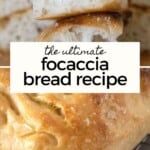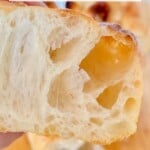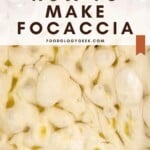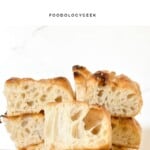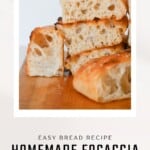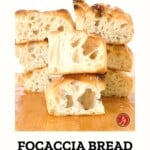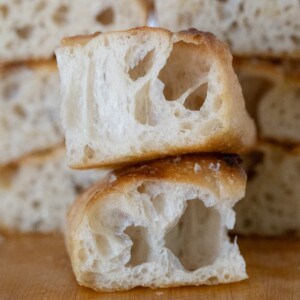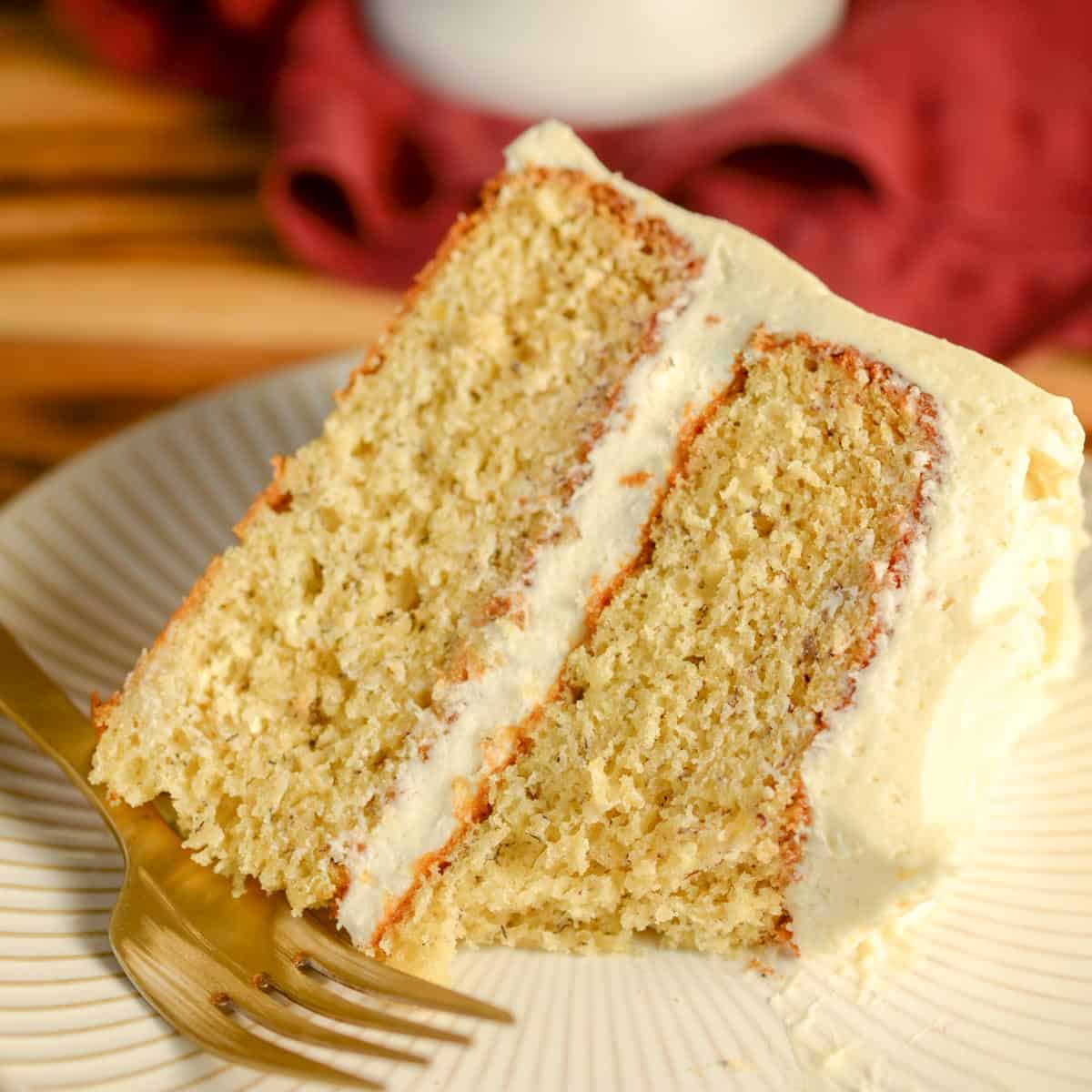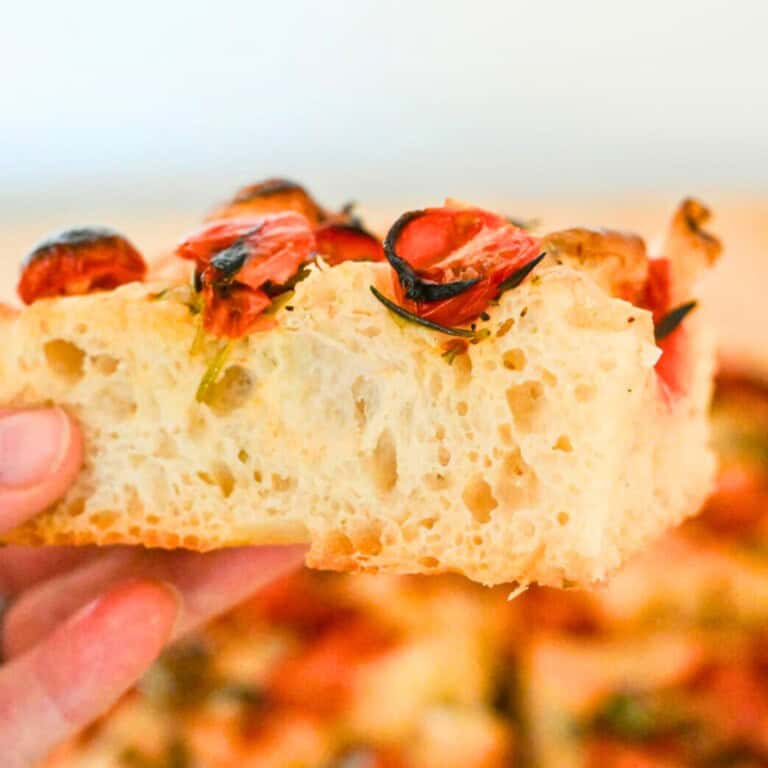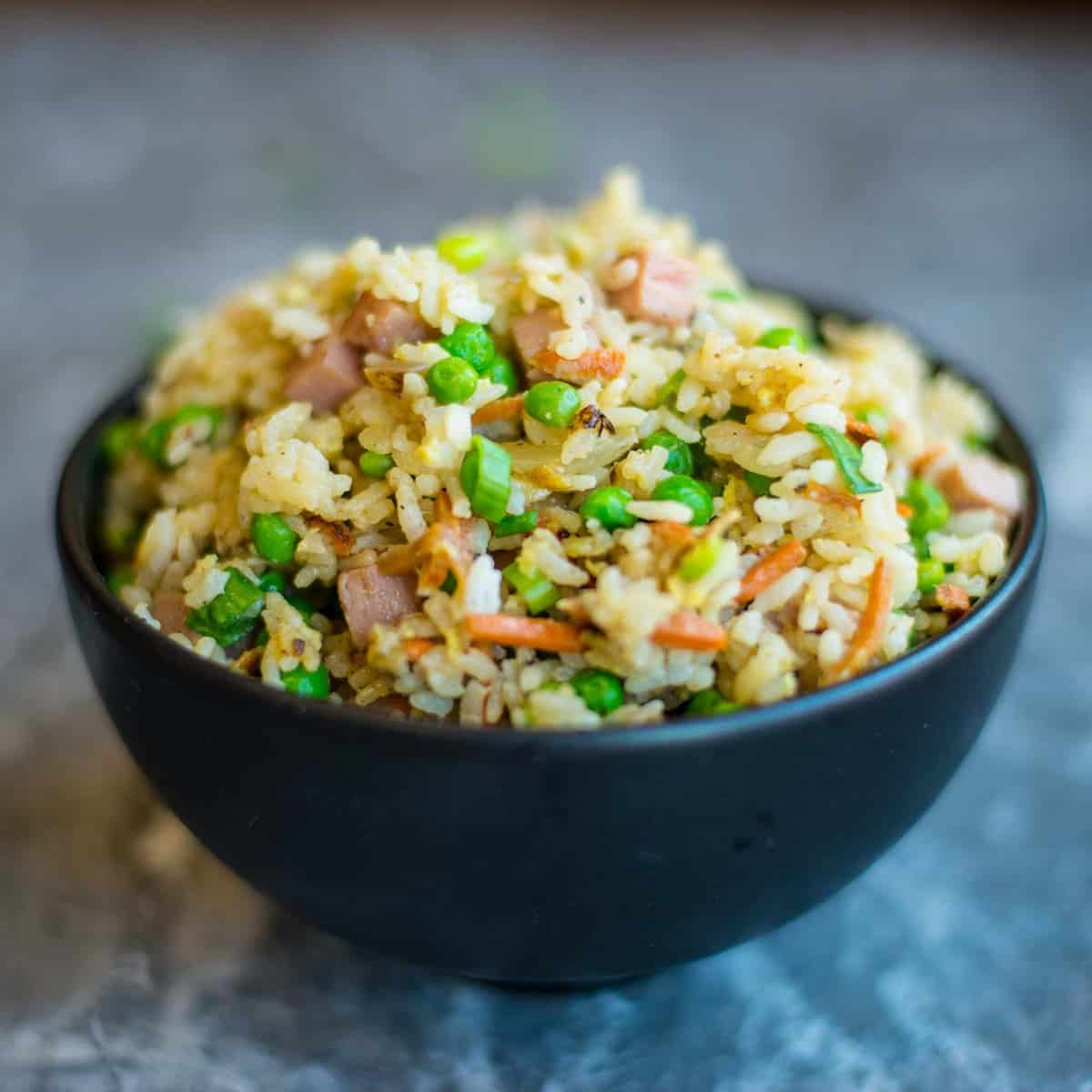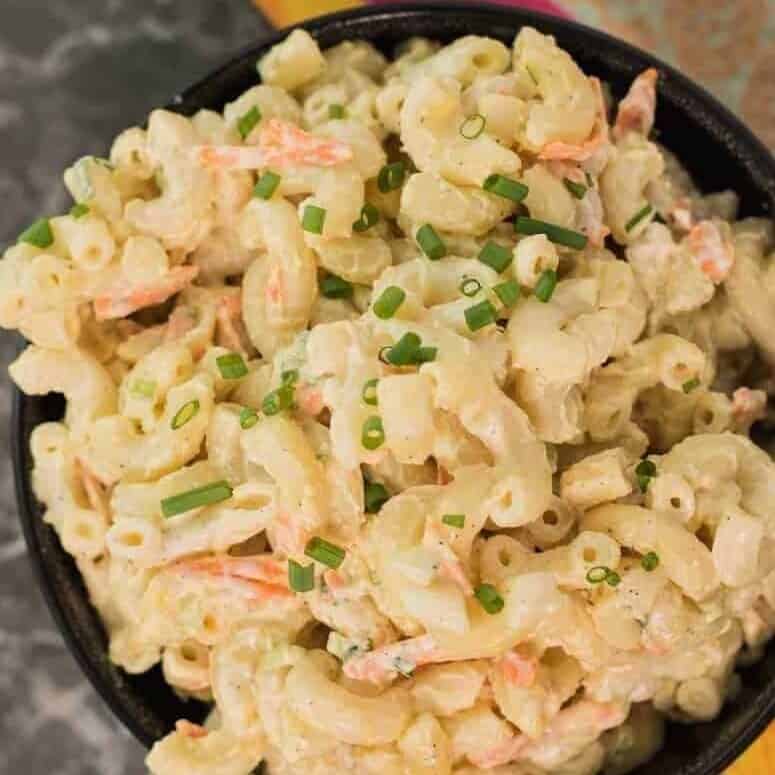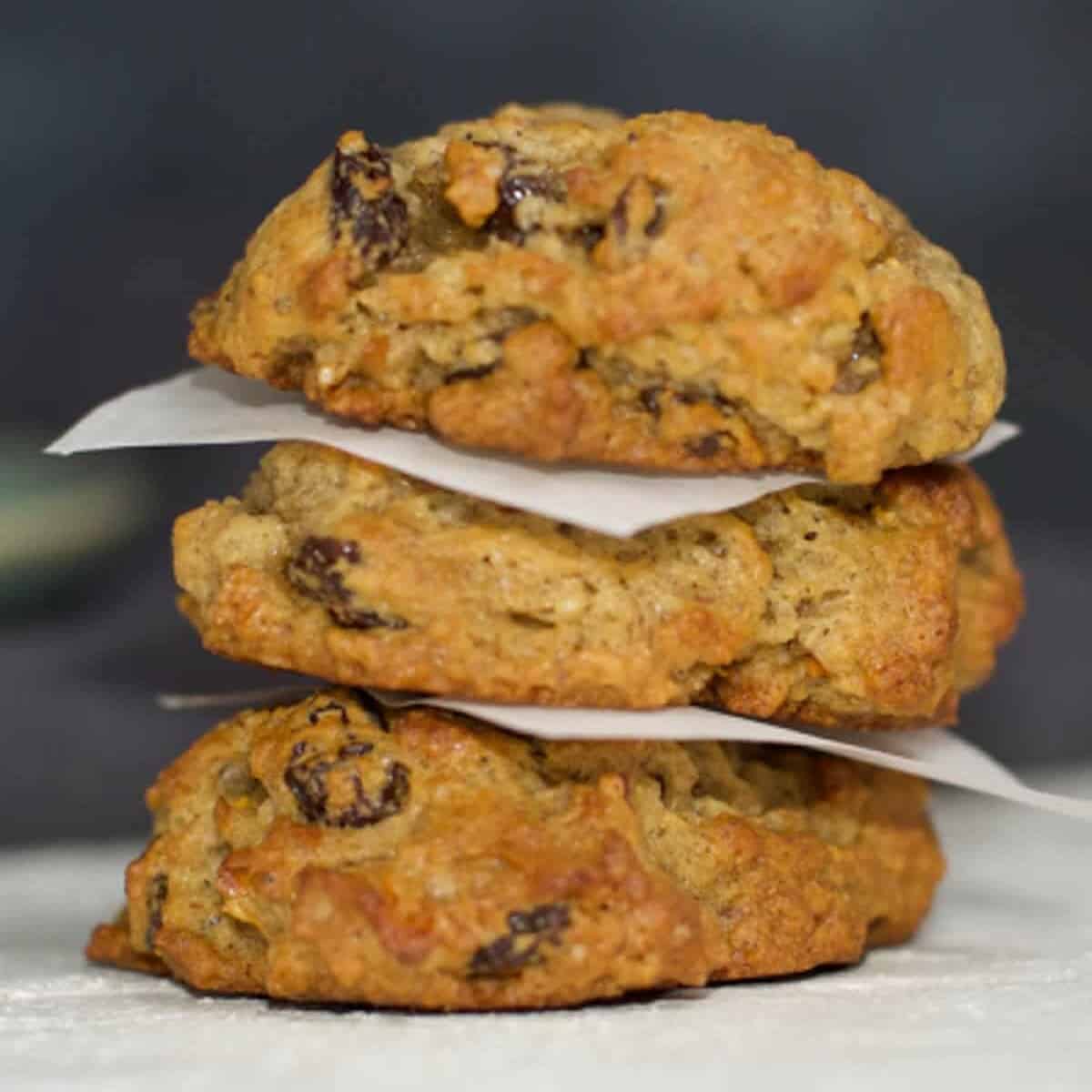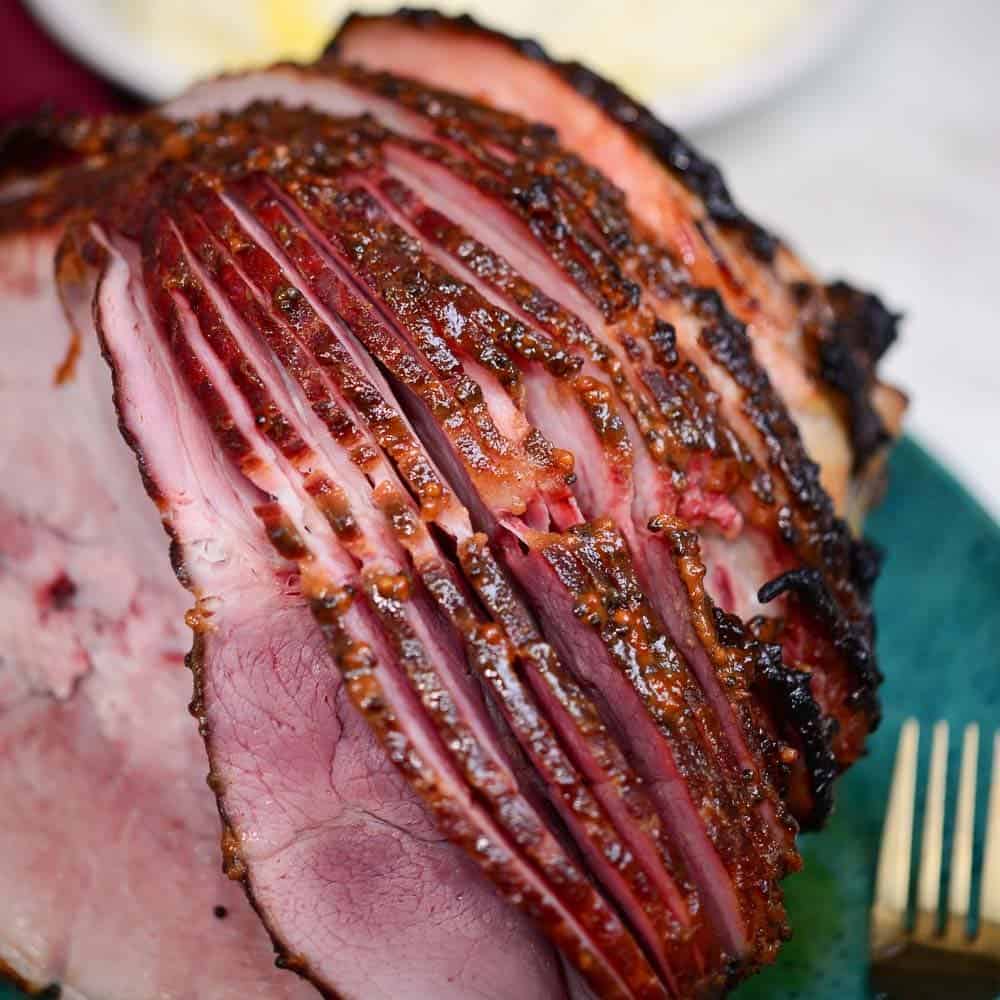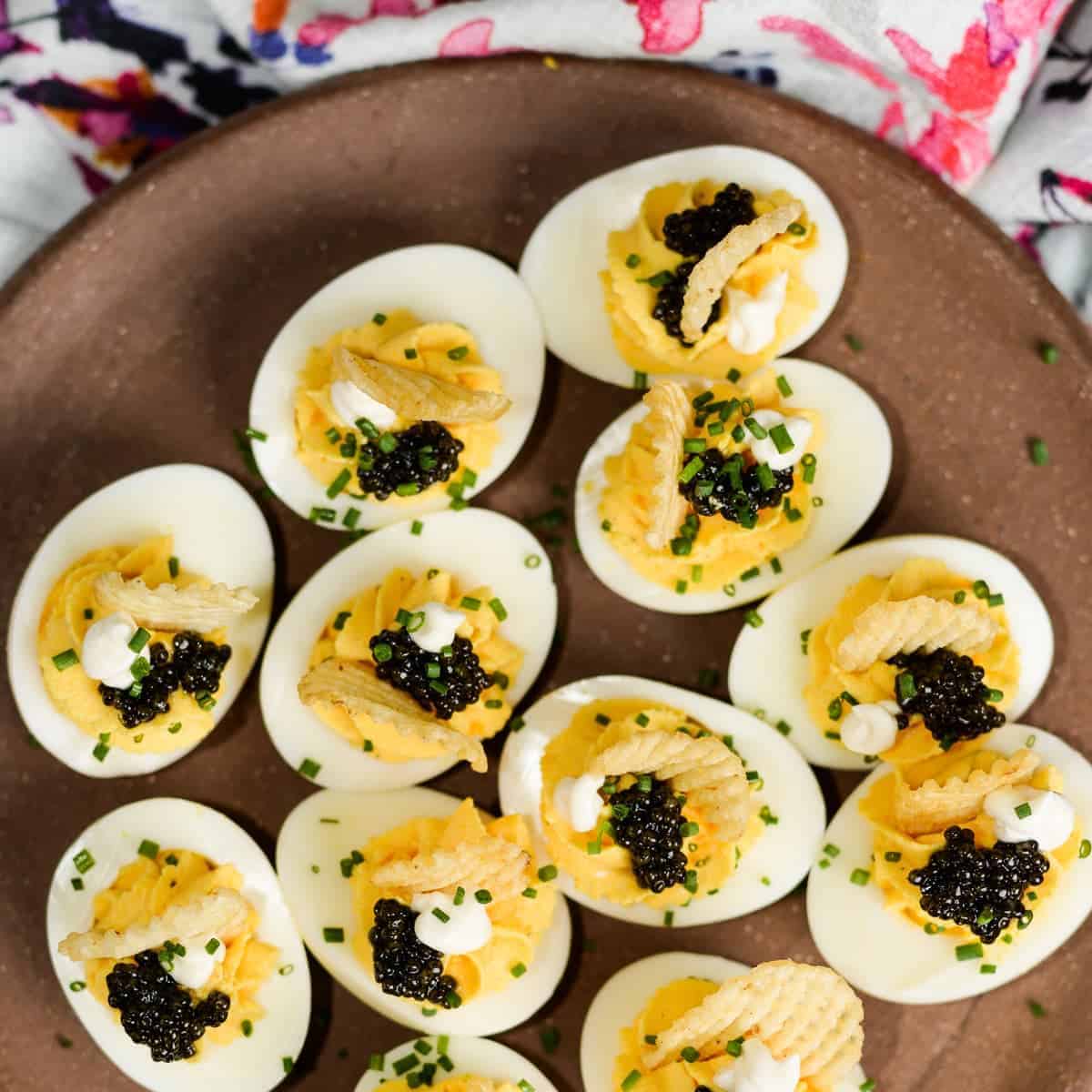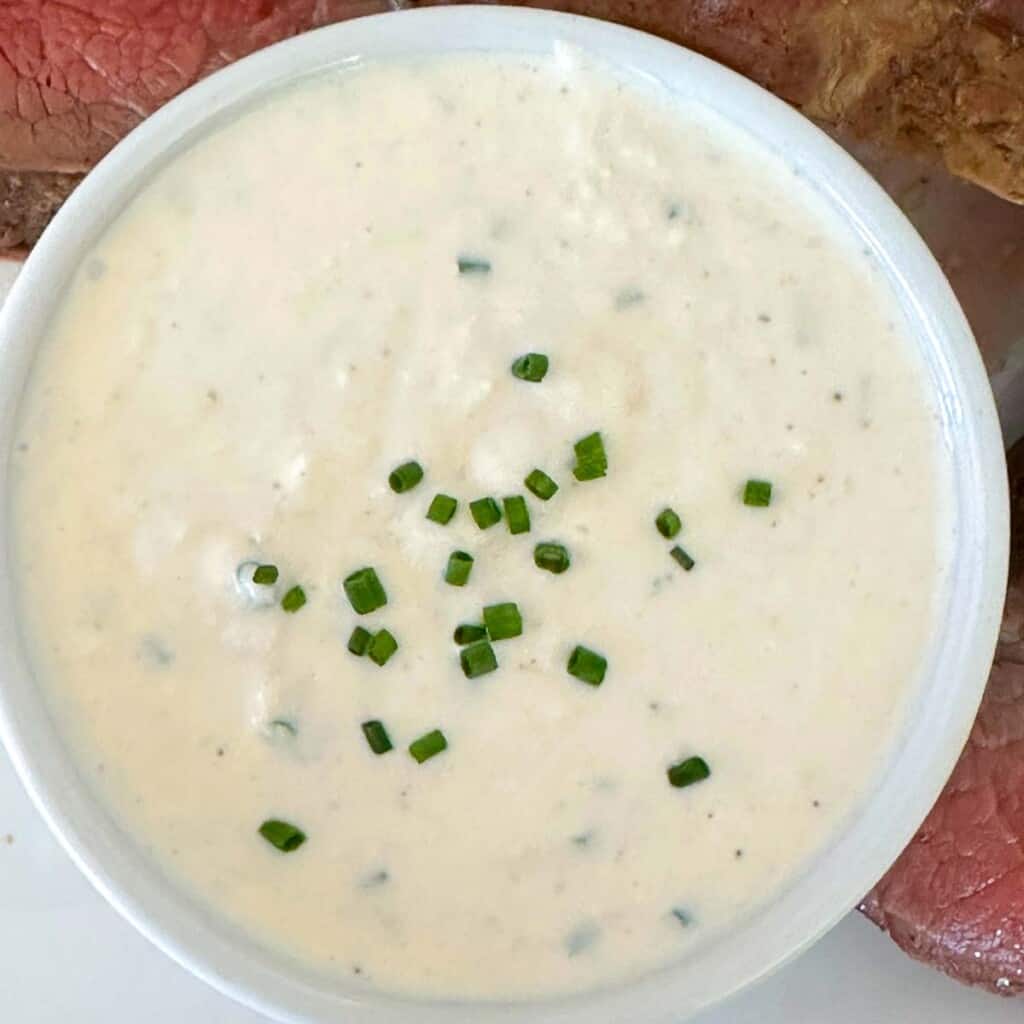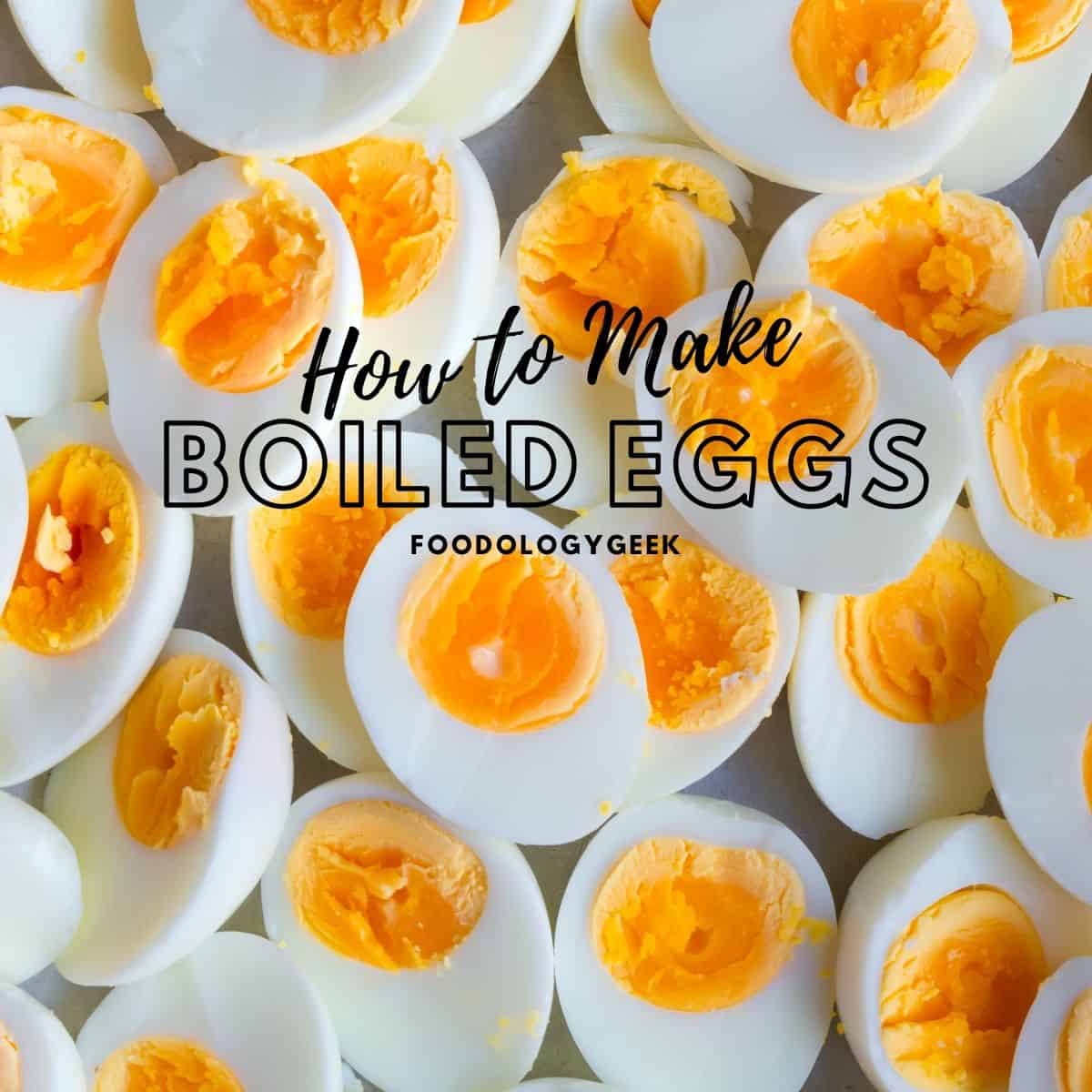Focaccia Bread Recipe
This is an easy-to-make, no-knead focaccia bread. The result is a perfect focaccia, tender and moist on the inside inside with huge pillowy bubbles. The outside is perfectly browned and chewy. If you’ve ever wanted to know all the secrets to making focaccia bread at home, this post is for you!
This recipe employs a high-hydration dough and is cold-proofed overnight. Cold-proofing bread dough develops flavor by allowing the yeast to slowly ferment. As the yeast feed on the proteins and starches in the dough, they ferment and release flavor-boosting goodness.
This dough is cold-proofed in the fridge for up to 3 days before baking. But I’ll also give you the directions if you want to bake this focaccia bread the same day.
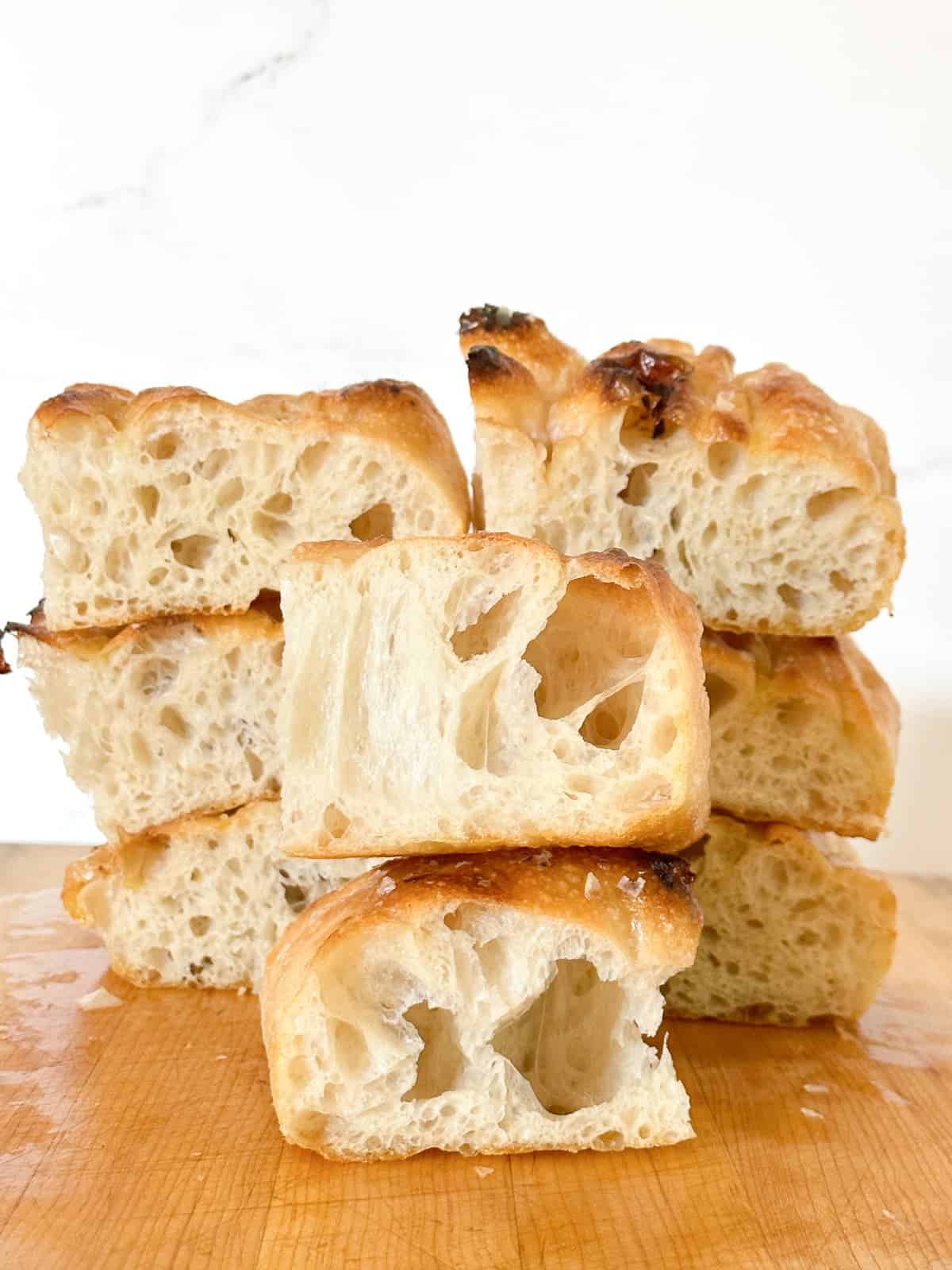
Check out more Focaccia Bread
Click to see our Tomato Focaccia Bread, which is also an amazing focaccia bread pizza crust.
Ingredients You’ll Need
You’ll need a few simple ingredients to make no-knead focaccia bread. You can use these same ingredients for any focaccia bread recipe.
- Bread flour: To get that tender but chewy texture, use a high-gluten flour with 12-14% protein.
- Instant yeast: Make sure your water is warm but not too hot. If you have a thermometer, your water should be no hotter than 110℉.
- Water: Use lukewarm water. Focaccia bread is a high-hydration dough. At around 80-88% hydration, this dough will be sticky. The high hydration allows for the large air pockets when rising.
- Kosher salt: I use the Morton or Diamond brand.
- Olive oil: This recipe requires lots of extra-virgin olive oil.
- Flakey sea salt: Add flaky salt to the top of the bread before baking. I recommend Maldon or Fleur de Sel.
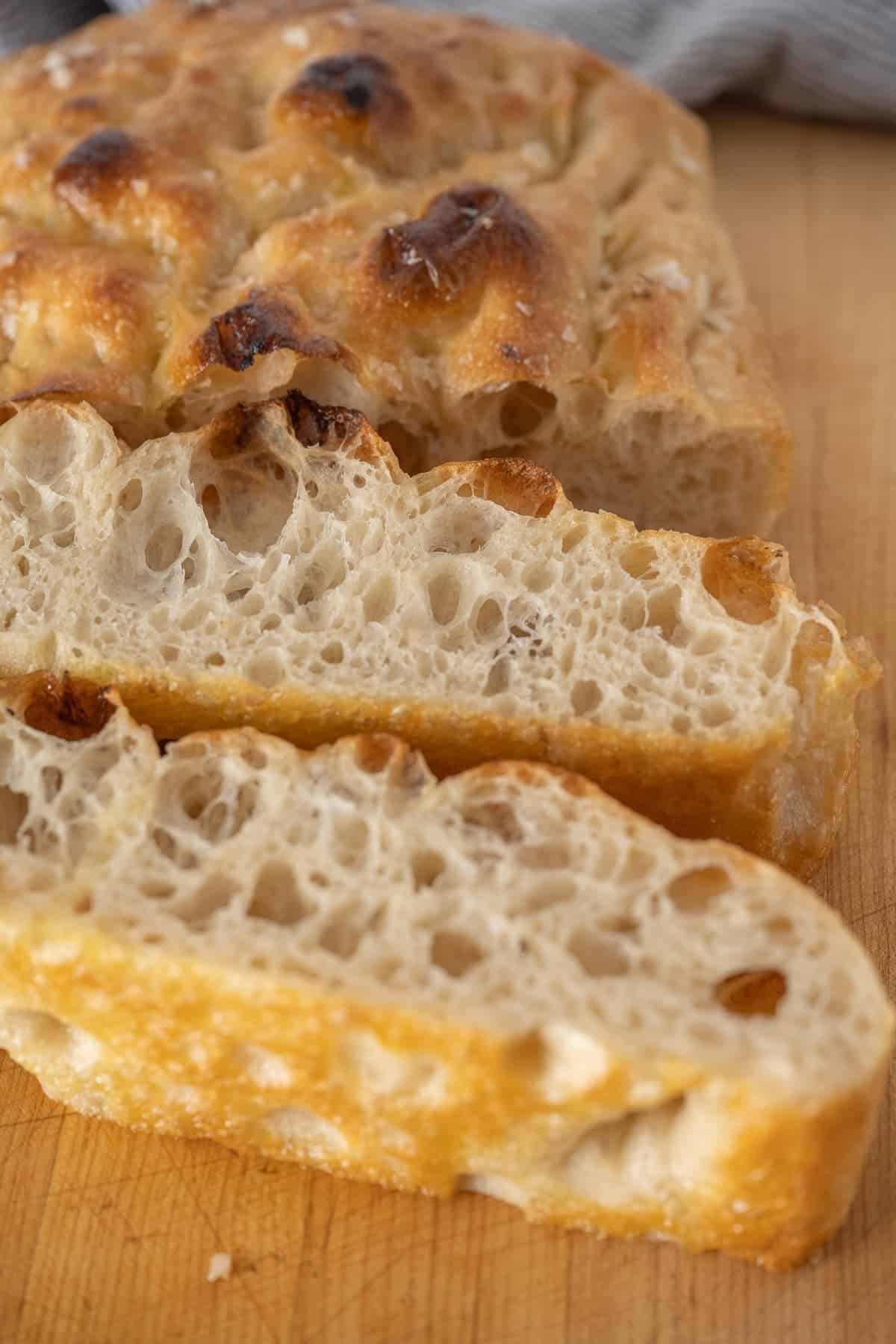
Step-By-Step Instructions For No Knead Focaccia
Making homemade focaccia bread is a simple process. But, it does require learning what to look for in the dough to get the perfect texture every time.
Step 1—Combine the Ingredients:
Add all the bread ingredients to a bowl. If you have a scale, weigh the ingredients directly into the bowl.
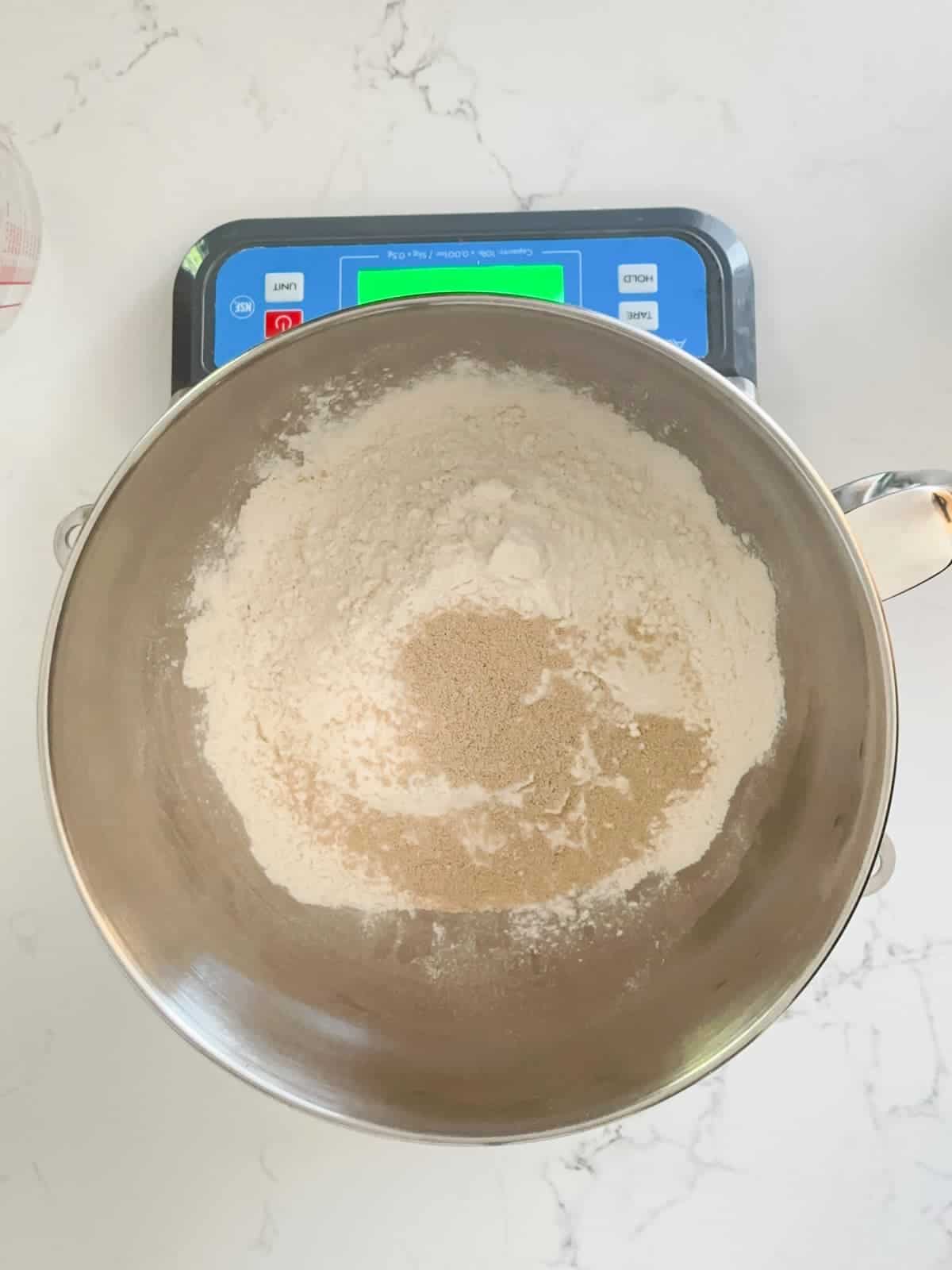
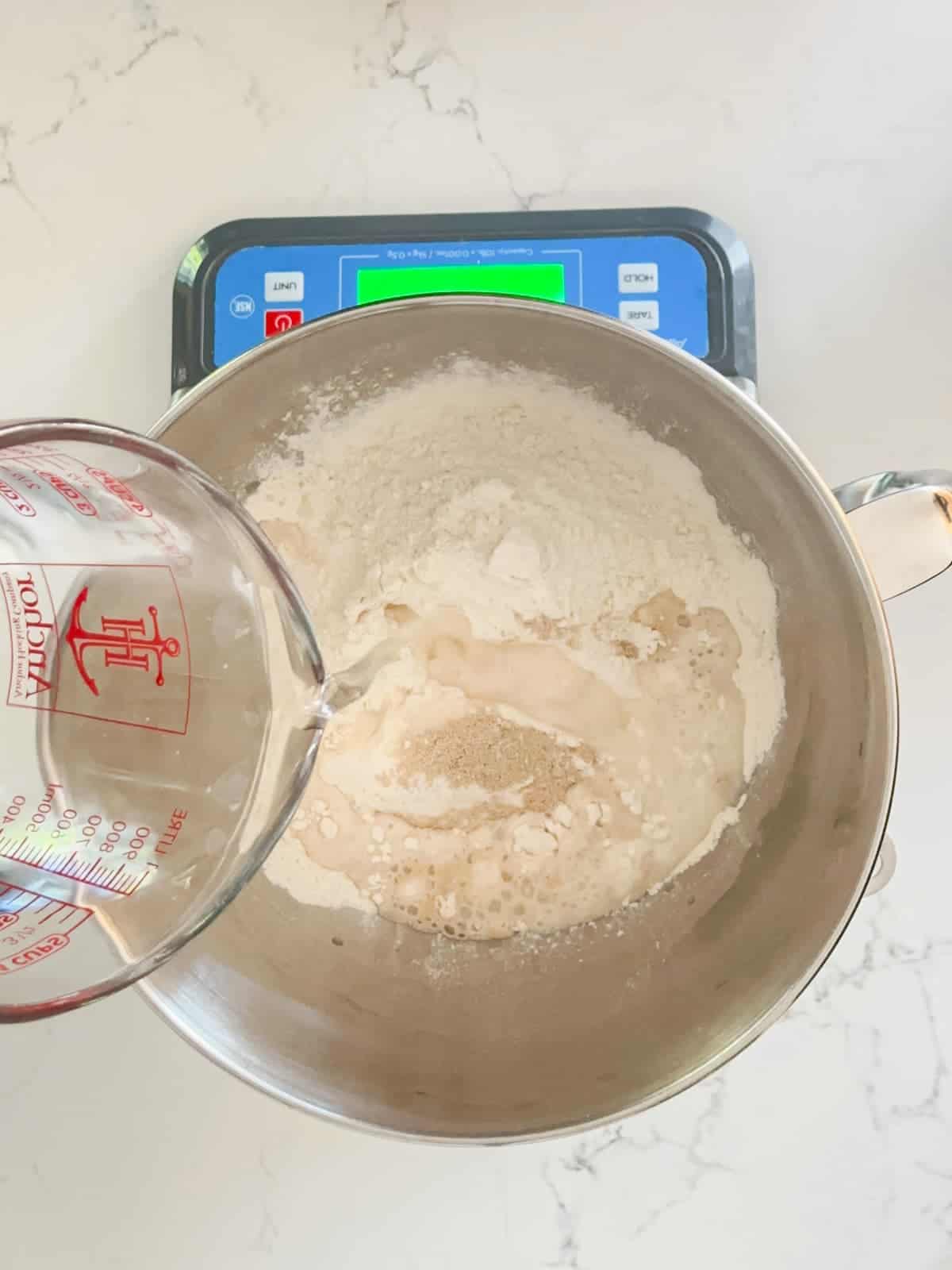
Step 2—Mix the Dough:
Mix the dough with a wooden spoon. The dough will be very wet and sticky. That’s what you want. It will start to come together in the following steps.
Step 3—First Rise:
Cover the bowl with plastic wrap or a large damp towel. We will be using the pull-and-turn method to develop gluten and large air pockets.
Let the dough rest for 30 minutes. After 30 minutes, use hands moistened with water to pull one corner of the dough to the opposite side. Turn the bowl one-quarter, and repeat 3 more times.
Recover the bowl and let it sit for another 30 minutes. You will repeat this process 3 times for a total of pull-fold-turns.
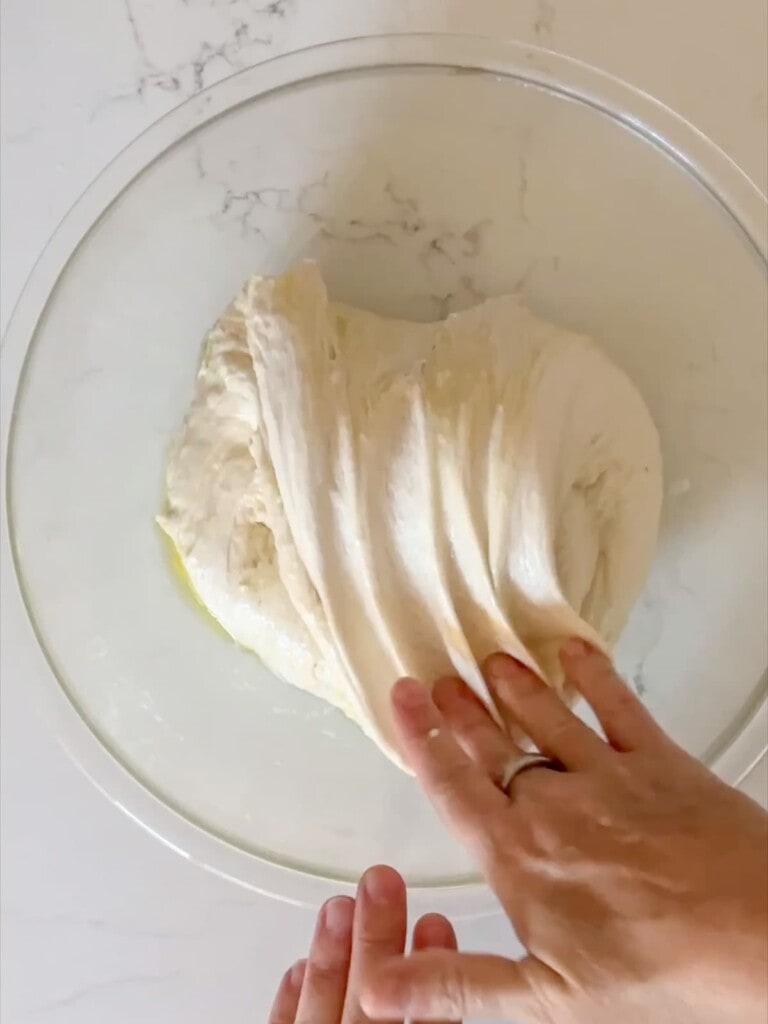
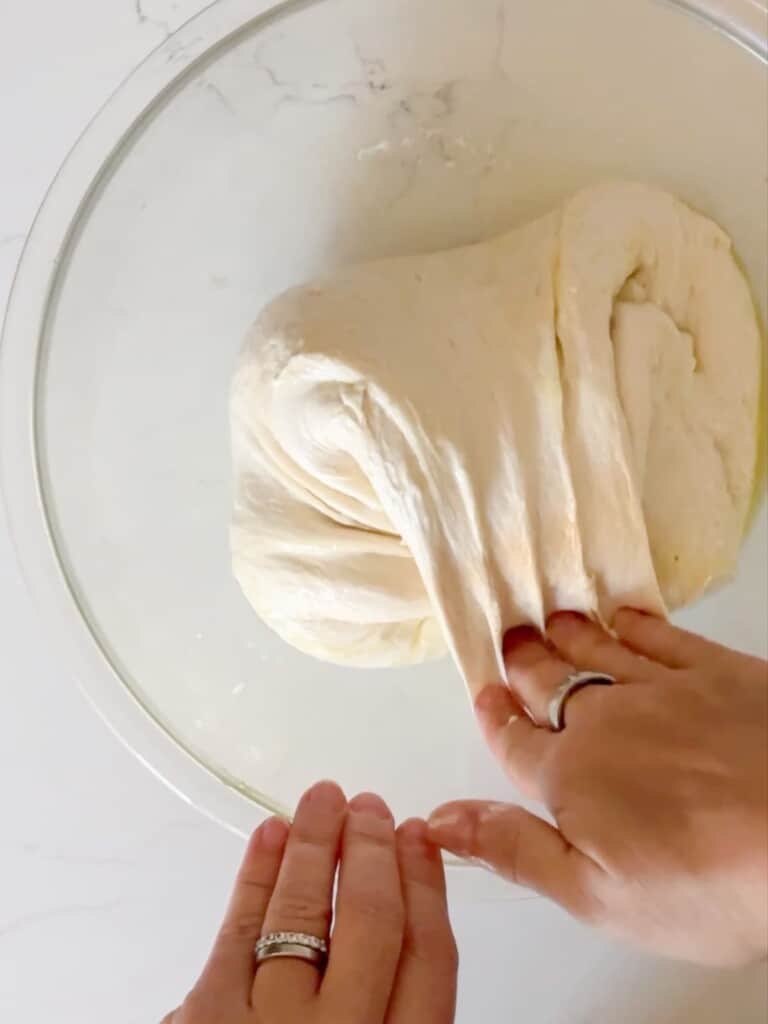
Step 4—Cold-proof:
Slather the tops of the dough with a generous helping of olive oil. Cover the bowl tightly with plastic wrap. Place the bowl in the fridge for 12 hours (up to 3 days.)
Want bread today? This step is optional. If you are short on time or want to make your bread today, skip this step and continue. The second rise will also be a lot shorter—30 minutes up to an hour. This requires watching and waiting for those signature bubbles.
Step 5—Second Rise:
Remove the dough from the refrigerator and let it sit at room temperature for about one. Generously oil a 9×13 baking pan. Gently dump the dough into the baking pan.
Drizzle more olive oil onto the top of the dough. Cover the pan with plastic wrap and cover with a kitchen towel OR an inverted, rimmed baking sheet. Allow the bread to rise at room temperature for 3 to 4 more hours.
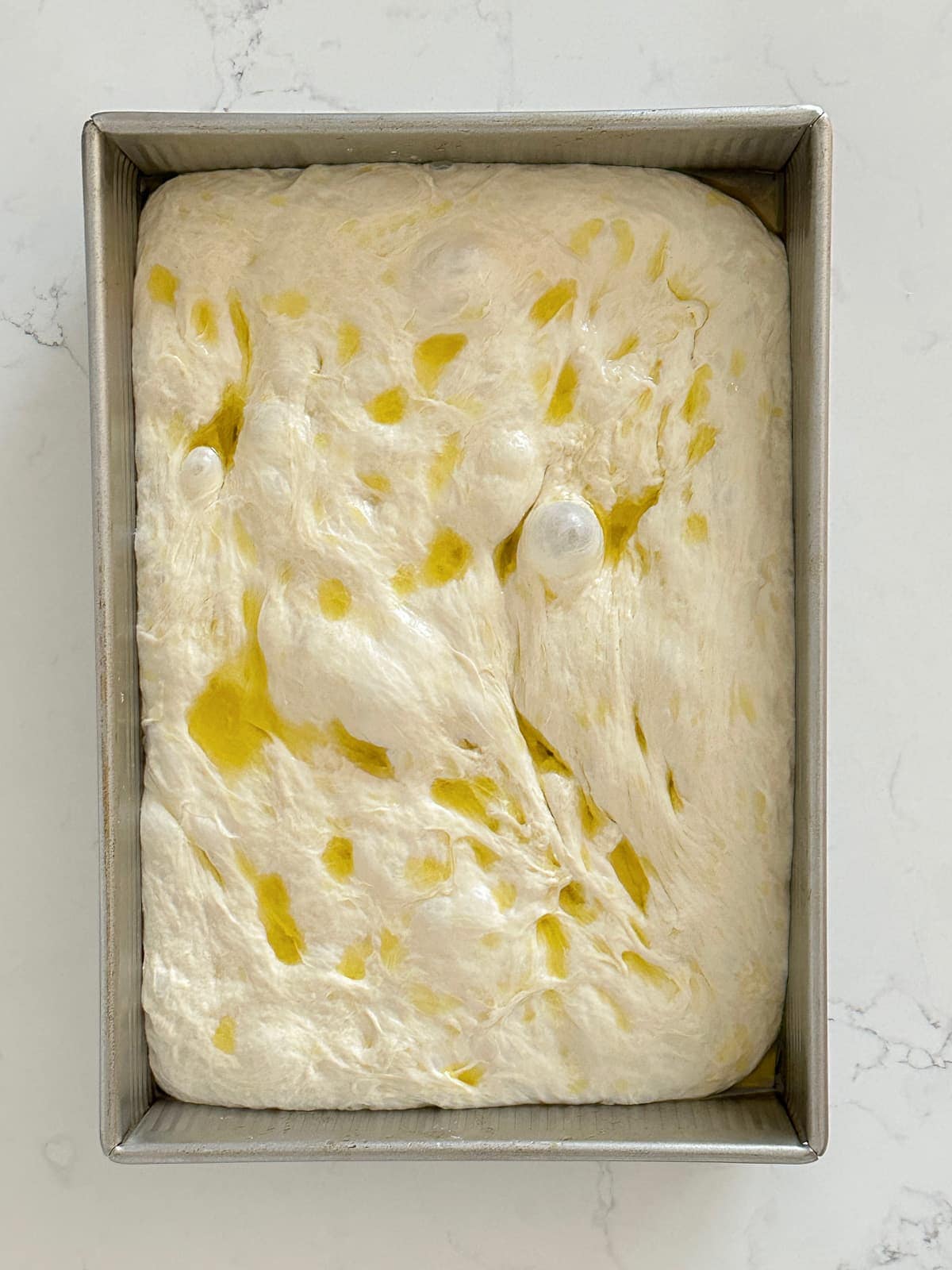
After 3 to 4 hours, drizzle the top of the dough with even more olive oil. Cover your fingertips in olive oil and press your fingertips into the surface to dimple the dough.
You want to press gently and jiggle to encourage the air to rise to the surface of the dough.
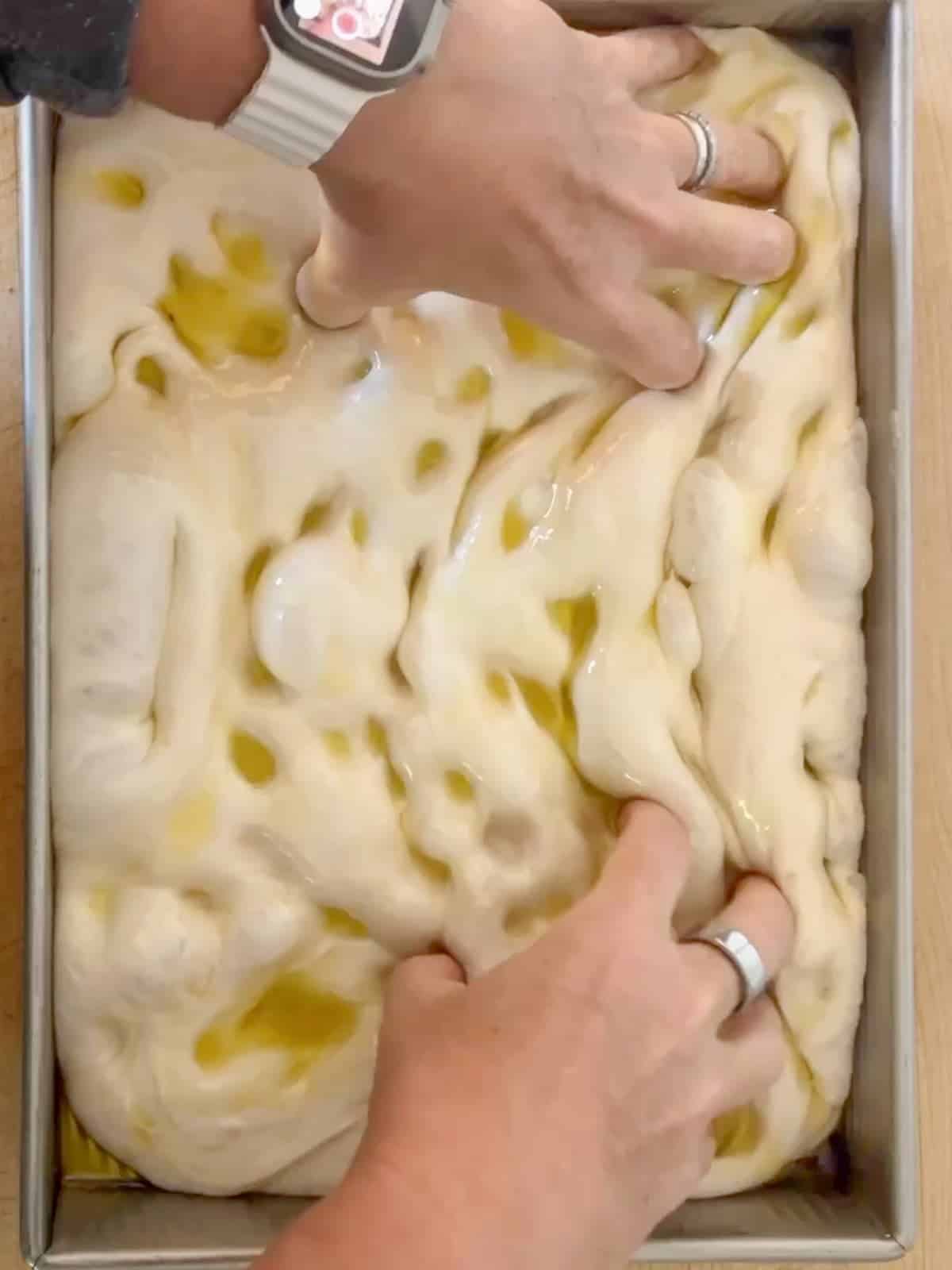
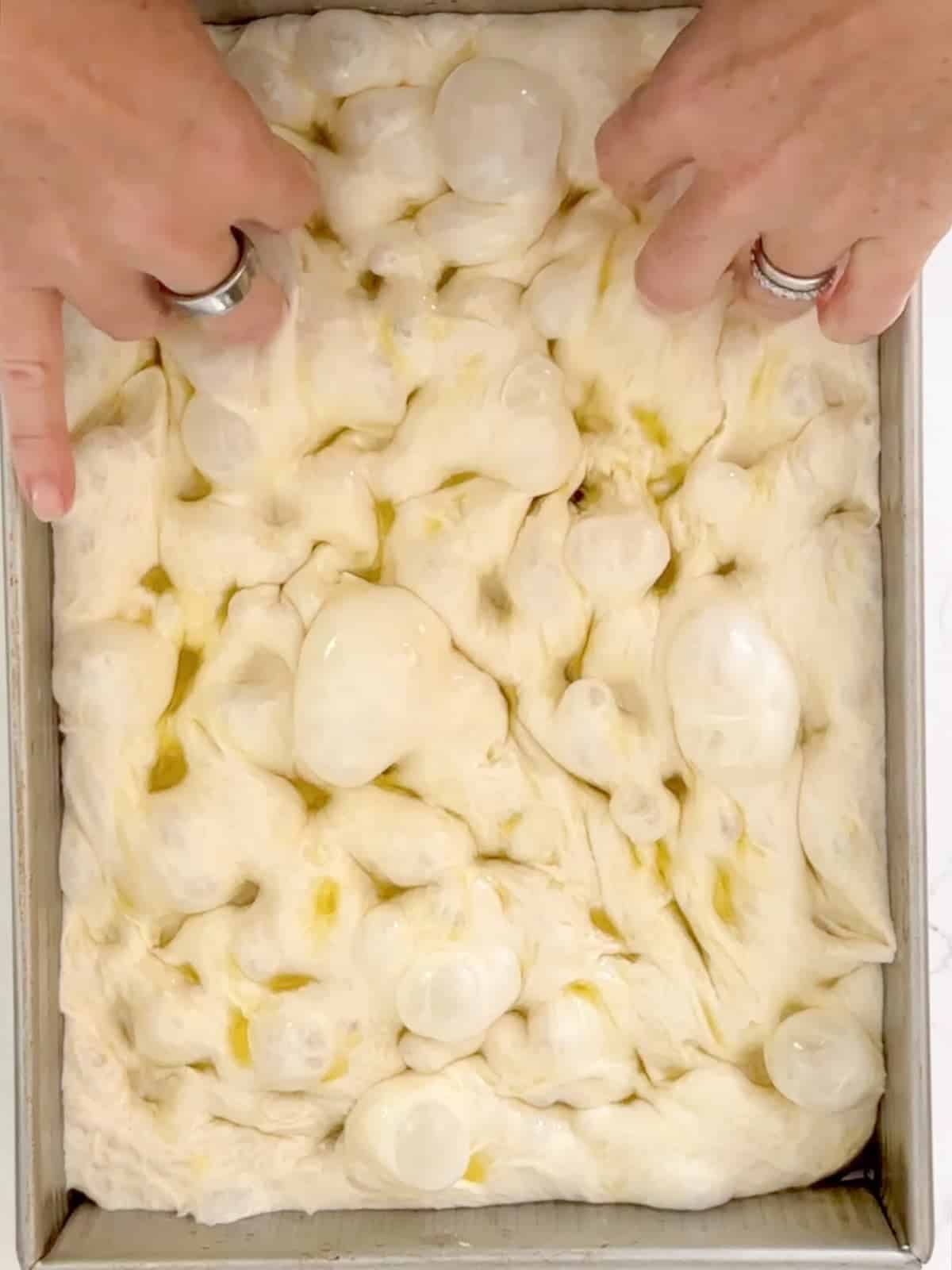
Step 6—Preheat your oven:
Adjust the racks to the bottom middle position. Add a baking stone if you have one. Set the oven to convection bake and preheat 500℉/260℃
Add flakey salt and olive oil to the top of the dough. See below for more suggestions on the best toppings for focaccia bread.
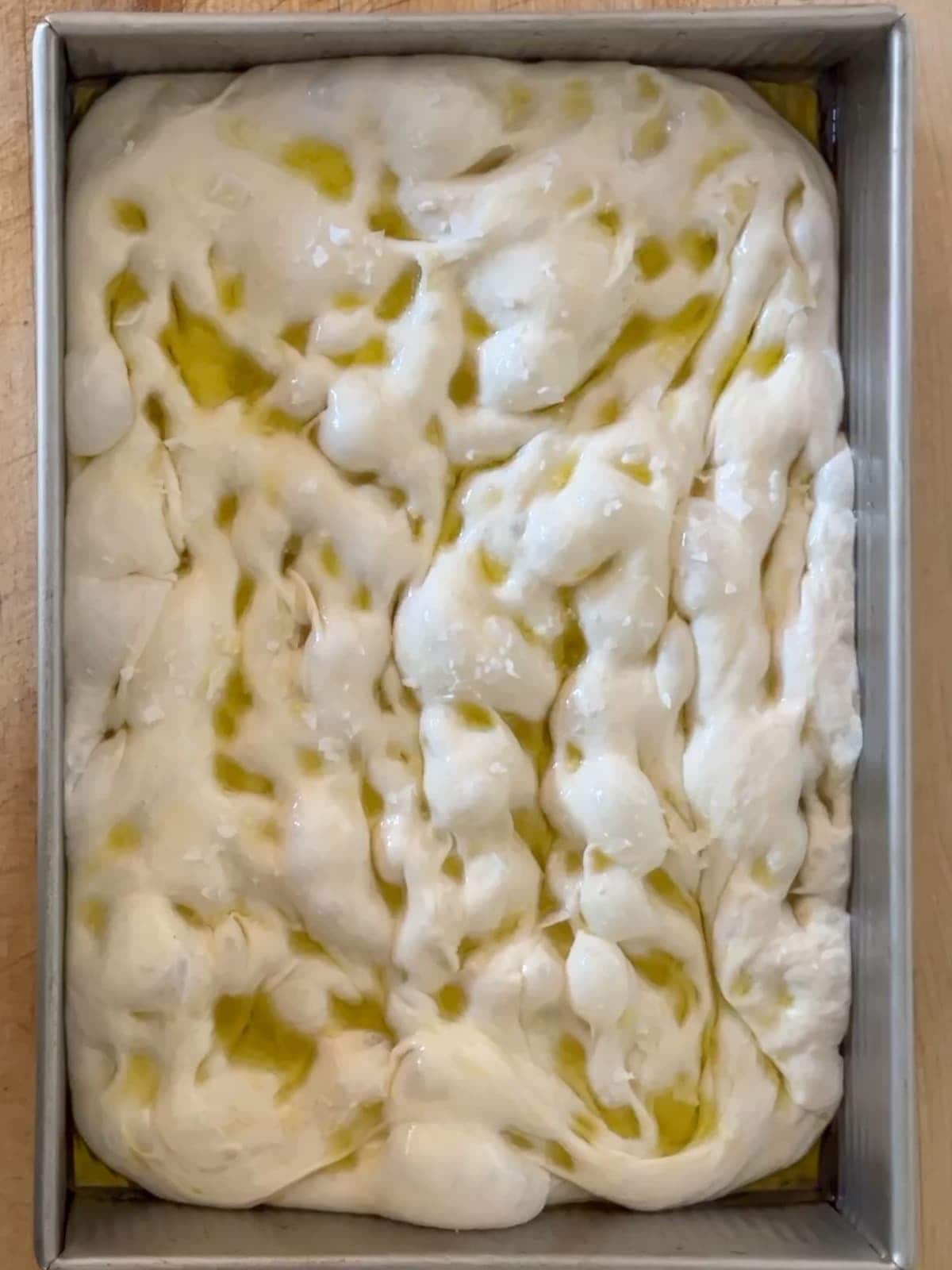
Bake the focaccia for 25-30 minutes until golden brown.
Rest the bread for 10 minutes in the pan and then transfer it to a baking rack to cool. Cool for 15 minutes before slicing.
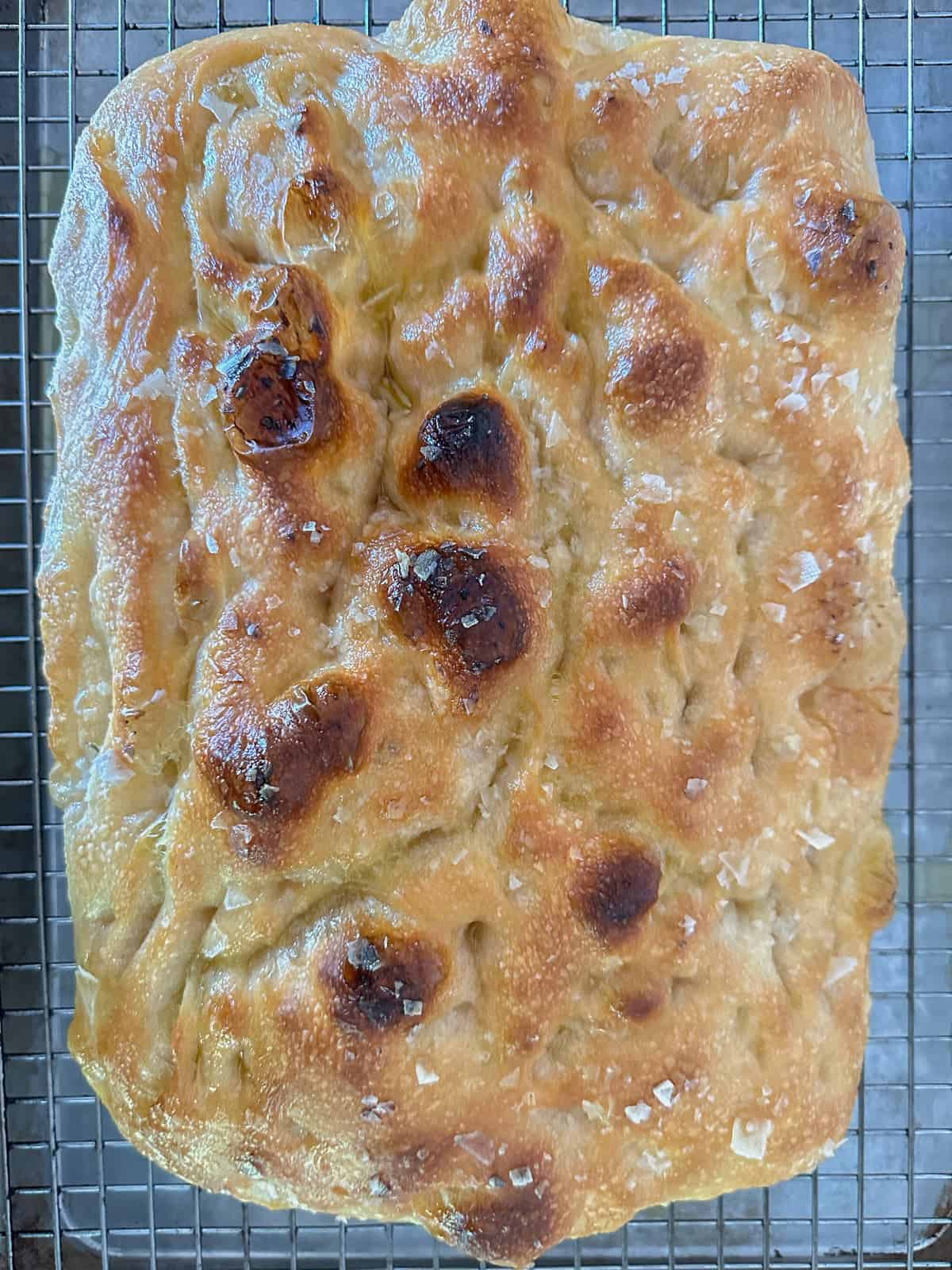
Tips For Homemade Focaccia Bread
Baking bread is all about learning the little nuances of what to look for. Like what should the dough look like? Knowing when it’s properly proofed.
- Use high-quality bread flour: I recommend King Arthur Brand in the US. Bread needs lots of gluten protein to make soft dough with air pockets. The high-protein flour also gives you the right texture and chew, for which focaccia bread is famous.
- Measure the ingredients with a scale: Use a scale to measure ingredients for bread. It’s the best way to get reliable and consistent results. There is very inconsistent information on how much one cup of flour weighs. So weighing is always best when baking bread.
- Get the right hydration: Bread structure is built on hydration percentage. This is the ratio of flour to water. Focaccia bread should be 80-88% hydration. For example, [grams of bread × 0.80 = grams of water needed for 80% hydration] This recipe uses 80%, but you can add a little extra water if you want to increase the hydration.
- Use warm water: Warm water helps to ensure the bread rises properly. I usually microwave the water for about 1 minute in the microwave and then measure the temperature. Shoot for 100-110℉. If the water gets too hot, add a little cool water to decrease the temperature.
- Get the proper dough rise: Giving bread enough time to rise is essential to get the right texture. If the dough is underproofed, it will be dense and feel dry. If the dough is over-proofed, the bread will go flat.
- Lots of olive oil. Focaccia bread loves olive oil. Be generous with it. Add olive oil to the bottom of the pan, and then drizzle olive oil over the top of the dough.
You can read a little more about the science of gluten and flour here if you are as geeky as I am.
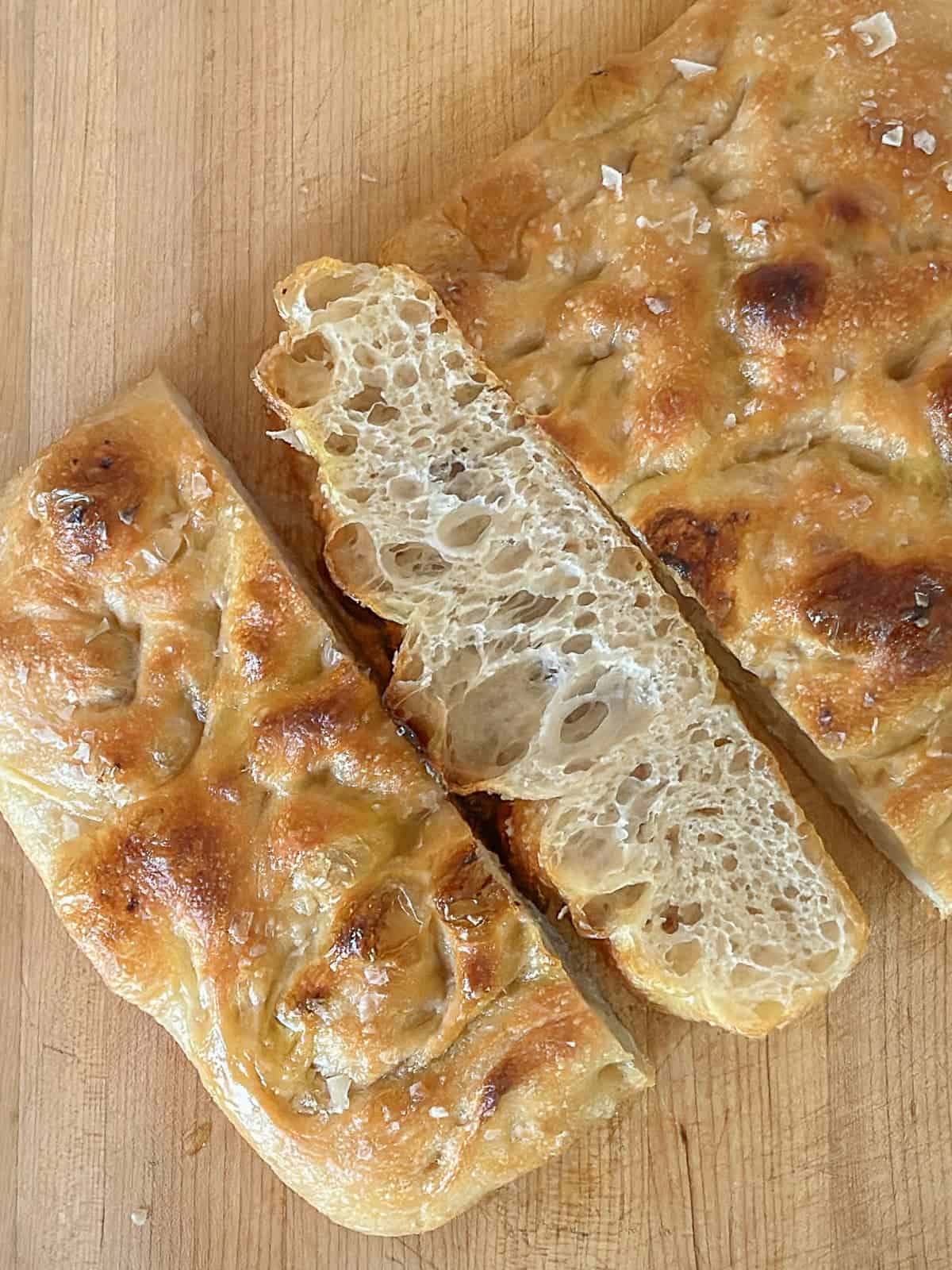
Troubleshooting Focaccia Bread
Focaccia bread has a light, chewy texture punctuated by its signature air pockets. A high-hydration dough is used when making focaccia. This extra moisture in the dough contributes to the light, airy texture and large air pockets.
- Dough texture: After mixing, the texture of the dough will be relatively wet and very sticky. Use wet hands to touch it so it doesn’t stick to you.
- Proofing: Focaccia dough requires two stages of proofing or rising.
- The First Rise: The first rise can also be extended as a cold-proof. The cold-proof is done in the refrigerator overnight (up to 3 days). Cold-proofing the dough develops considerable flavor and is well worth it if you have the time. If you cold-proof, make sure the dough is slathered with olive oil and is covered with plastic wrap. For same-day baking, the first rise is done at room temperature or in a proofing drawer set to 100℉.
- The Second Rise: The second rise is done in the baking pan. If you’ve cold-proofed the dough, the second rise will take about 3 to 4 hours. The dough is out of the fridge, so it takes more time to warm up and get air bubbles. For same-day baking, the second rise takes about 30 to 40 minutes.
- Bubbles: Temperature in the kitchen and dough affect rise time. The yeast releases CO𝟮 into the dough. The CO𝟮 is responsible for the formation of air pockets. If the dough is too cold, it will take longer for these bubbles to develop. Making bread is all about learning to detect the right textures in the dough.
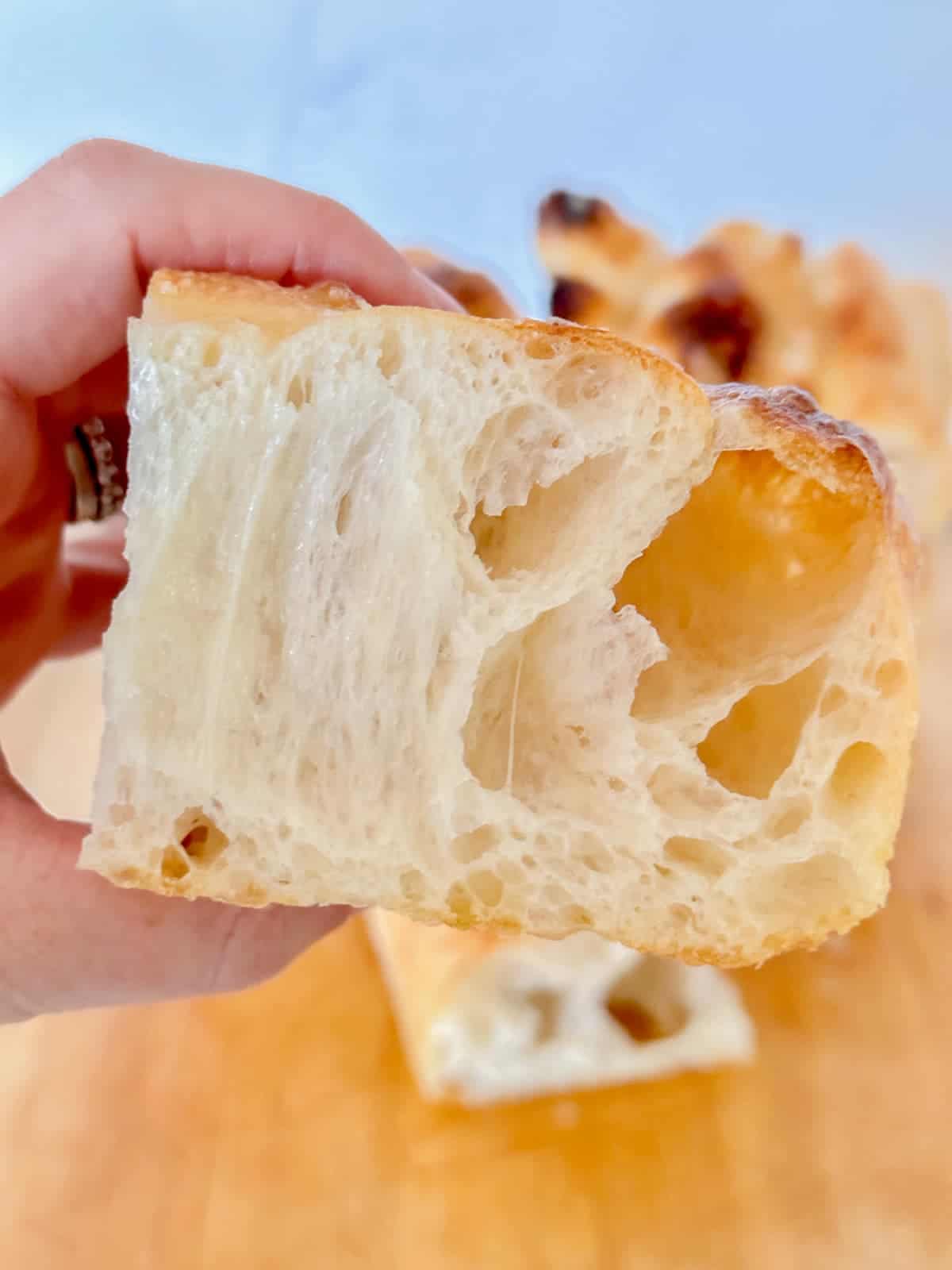
Toppings For Focaccia Bread
So many toppings taste fantastic on top of perfectly baked focaccia bread. Here are a few that I’ve made and highly recommend. To try different flavor combinations, add olive oil and flaky sea salt on top before baking. Always use fresh herbs..
- Flakey salt. This is the most straightforward topping to add to focaccia. Top with flake salt, no matter what other toppings are added. Use a salt like Maldon or Fleur de Sel.
- Rosemary Focaccia. Fresh rosemary is a classic topping. You can use fresh rosemary alone or combine it with roasted garlic and flakey salt if desired.
- Green Onions. Fresh green onions are another classic topping.
- Tomato focaccia. Tomatoes on focaccia become sweet and delicious when baked, complementing the olive oil and salt.
- Olives. Juicy olives are the perfect addition to this rustic bread. You can use kalamata olives, cerignola, Niçoise, or Manzanilla. Check out this post to find more olives that are worth trying.
- Caramelized onions and tart apples. I love this combo on bread. I also like to add a little gruyere to the top.
- Figs and lardons with thyme. This combination is savory and sweet. Drizzle with honey before serving.
- Proscuitto and peaches. This is a classic, savory, sweet combination. Fresh thyme is a great addition.
- Potato and rosemary. Slice potatoes very thin and top the bread with them. Add rosemary and, of course, olive oil and salt before baking.
- Basil Pesto. Fold pesto into the focaccia dough during the pull-and-fold step. Add even more to the top of the bread.
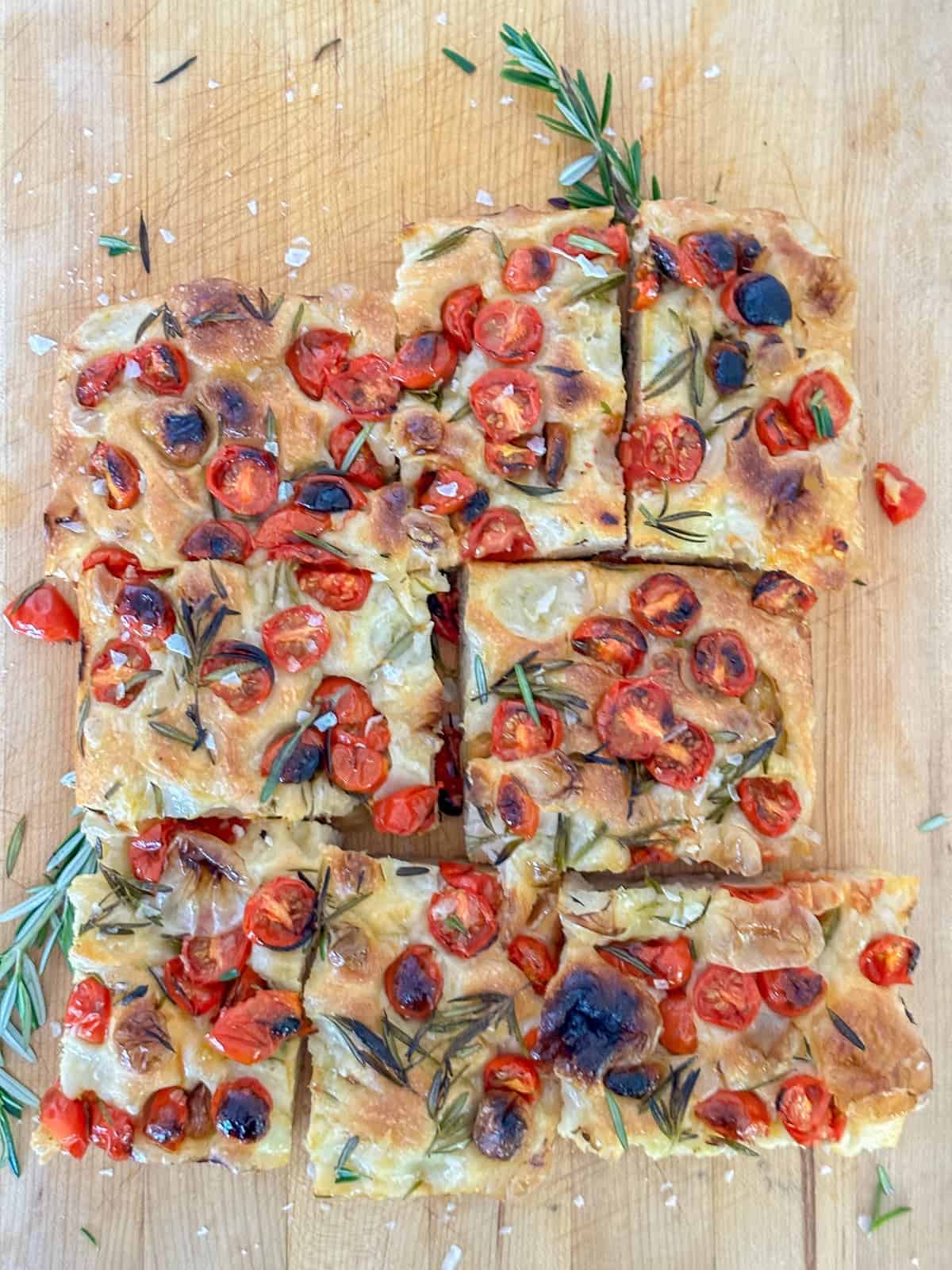
Serving Focaccia Bread
- Serve with fragrant olive oil and balsamic vinegar.
- Focaccia bread is good for sandwiches. Make a loaf, cut it into squares, and then slice it in half like a bun.
- Focaccia bread pizza: This simple recipe also works well for making grandma-style pizza on a sheet pan.
More Bread Recipes To Love
Definitely try our Tomato Focaccia Recipe! And here are some of our other favorite bread recipes.
No posts
Did you love this recipe?
Please leave a 5-star 🌟🌟🌟🌟🌟 rating and a comment below ⬇️
I love hearing from you in the comments; & your feedback helps other readers and helps me continue offering recipes at no cost. Drop a comment 👇
Easy No Knead Focaccia
Equipment
- food scale (affiliate link)
Ingredients
- 500 grams bread flour (affiliate link)
- 10 grams kosher salt (affiliate link), 2 teaspoons
- 8 grams instant yeast (affiliate link), 2 teaspoons
- 400 grams water, room temperature
- 1 ½ tablespoons olive oil (affiliate link)
- coarse salt (affiliate link), Maldon flake salt
Instructions
- Combine the Ingredients. Add all the bread ingredients to a bowl. If you have a scale, weigh the ingredients directly into the bowl.500 grams bread flour, 10 grams kosher salt, 8 grams instant yeast, 400 grams water, 1 ½ tablespoons olive oil
- Mix the Dough. Mix the dough with a wooden spoon. The dough will be very wet and sticky.
- First Rise. Oil a large bowl. Add your dough to the oiled bowl and cover with plastic wrap or a large damp towel. We will be using the pull-and-turn method to develop gluten and large air pockets. Let the dough rest for 30 minutes. After 30 minutes, use hands moistened with water to pull one corner of the dough to the opposite side. Turn the bowl one-quarter, and repeat 3 more times. Recover the bowl and let it sit for another 30 minutes. You will repeat this process 3 times for a total of pull-fold-turns.
- Cold-proof. Make sure the top of the dough is slathered with a generous helping of olive oil. Cover the bowl tightly with plastic wrap. Place the bowl in the fridge for 12 hours (up to 3 days.)
- Second Rise. Remove the dough from the fridge and let it come to room temperature for one hour. Prepare a 9×13-inch baking pan. Generously oil a 9×13 baking pan. After one hour, gently dump the dough into the baking pan. Drizzle more olive oil onto the top of the dough. Cover the pan with plastic wrap and cover with a kitchen towel OR an inverted, rimmed baking sheet. Allow the bread to rise at room temperature for 3 to 4 more hours. You want to make sure you are getting a lot of large bubbles in the dough. [note 1]
- Dimple the dough. After 3 to 4 hours, drizzle the top of the dough with even more olive oil. Cover your fingertips in olive oil and press your fingertips into the surface to dimple the dough. You want to press gently and jiggle to encourage the air to rise to the surface of the dough.
- Preheat your oven: Set up a middle rack. Set the oven to convection bake and preheat the oven 500℉/260℃.
- Add your toppings to the top of the dough. Make sure the toppings are oiled so that they don't burn. See below for suggestions on the best toppings for focaccia bread.coarse salt
- Bake for 25-30 minutes until golden brown. Rest the bread for 10 minutes in the pan and then transfer it to a baking rack to cool. Cool for 15 minutes before slicing.
Laura’s Tips + Notes
- If the dough seems like it’s not rising or you aren’t getting many large bubbles, you might want to find a warmer place to proof the dough. You can do this by warming your oven to the lowest setting and then turning it off. Place the covered pan in the warm oven.
Yummy Focaccia Topping Variations
-
- Flakey salt. This is the most straightforward topping to add to focaccia. I use flake salt no matter what other toppings are added. Use a salt like Maldon or Fleur de Sel.
-
- Rosemary Focaccia. Fresh rosemary is a classic topping. If desired, you can use fresh rosemary alone or combine it with roasted garlic and flakey salt.
-
- Green Onions. Fresh green onions are another classic topping.
-
- Tomato focaccia. Fresh tomatoes caramelized on top of focaccia when it’s baking and give it a sweet element that tastes amazing with the olive oil and a little salt.
-
- Olives. Juicy olives are the perfect addition to this rustic bread. You can use kalamata olives, cerignola, Niçoise, or Manzanilla. Check out this post to find more olives that are worth trying.
-
- Caramelized onions and tart apples. I love this combo on bread. I also like to add a little gruyere to the top.
-
- Figs and lardons with thyme. This combination is savory and sweet. Drizzle with honey before serving.
-
- Proscuitto and peaches. This is a classic, savory, sweet combination. Fresh thyme is a great addition.
-
- Potato and rosemary. Slice potatoes very thin and top the bread with them. Add rosemary and, of course, olive oil and salt before baking.
-
- Basil Pesto. Pesto can be folded into the focaccia dough during the pull-and-fold step. It can all be added to the top.
YOUR OWN NOTES
Sign In to add your own private notes

